2016 TOYOTA LAND CRUISER check engine light
[x] Cancel search: check engine lightPage 433 of 608

433
LC200_OM_OM60M88U_(U)
6Maintenance and care
6-1. Maintenance and careCleaning and protecting the vehicle exterior .......... 434
Cleaning and protecting the vehicle interior ........... 437
6-2. Maintenance Maintenance requirements ................... 440
General maintenance........ 443
Emission inspection and maintenance (I/M)
programs ......................... 446
6-3. Do-it-yourself maintenance Do-it-yourself service precautions ..................... 447
Hood ................................. 449
Engine compartment ......... 450
Tires .................................. 463
Tire inflation pressure ....... 472
Wheels .............................. 475
Air conditioning filter.......... 477
Electronic key battery........ 479
Checking and replacing fuses ............................... 481
Headlight aim .................... 485
Light bulbs......................... 487
Page 458 of 608
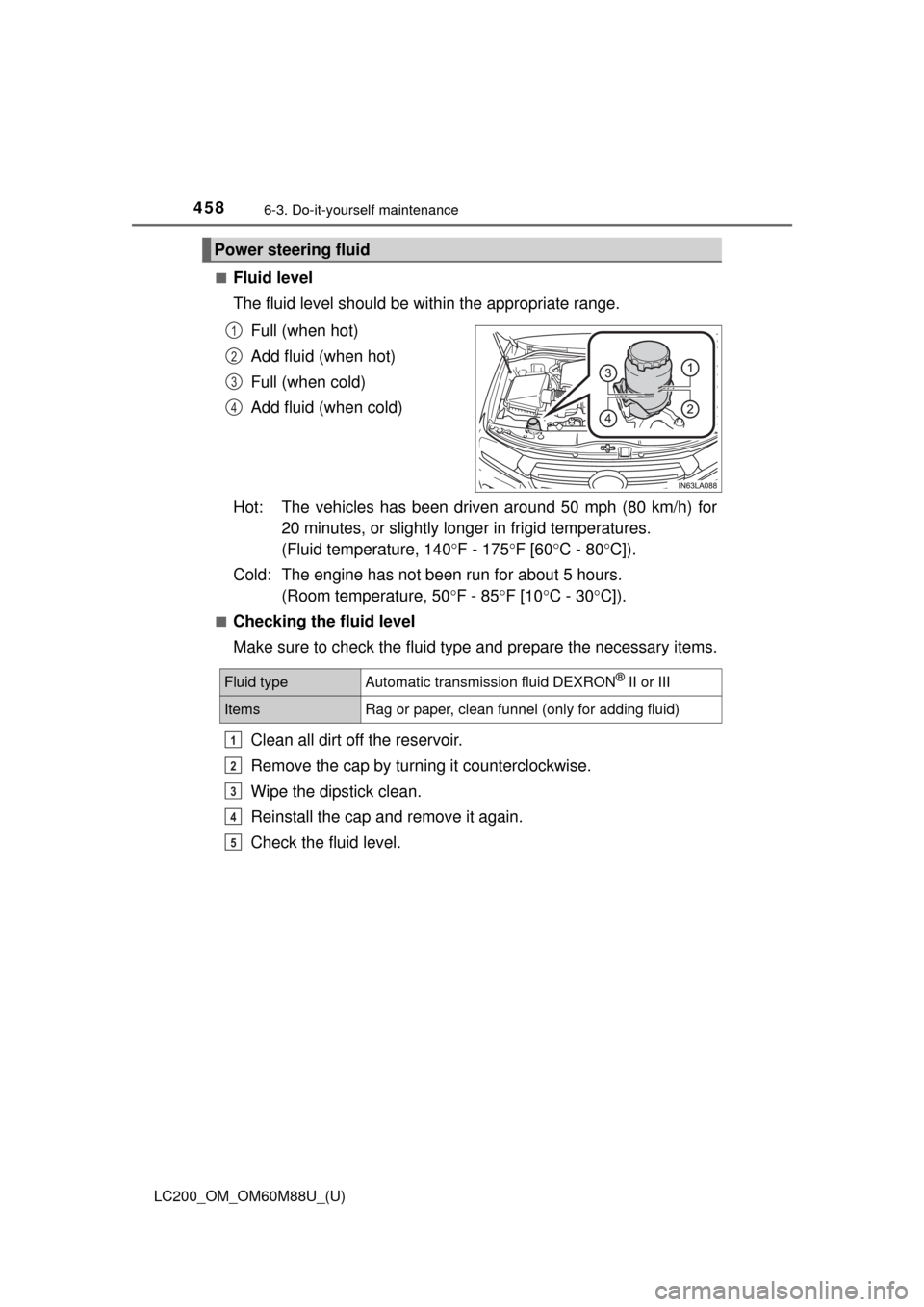
458
LC200_OM_OM60M88U_(U)
6-3. Do-it-yourself maintenance
■Fluid level
The fluid level should be within the appropriate range.Full (when hot)
Add fluid (when hot)
Full (when cold)
Add fluid (when cold)
Hot: The vehicles has been driven around 50 mph (80 km/h) for 20 minutes, or slightly longe r in frigid temperatures.
(Fluid temperature, 140 F - 175F [60C - 80 C]).
Cold: The engine has not been run for about 5 hours. (Room temperature, 50 F - 85F [10C - 30 C]).
■Checking the fluid level
Make sure to check the fluid type and prepare the necessary items.
Clean all dirt off the reservoir.
Remove the cap by turn ing it counterclockwise.
Wipe the dipstick clean.
Reinstall the cap and remove it again.
Check the fluid level.
Power steering fluid
1
2
3
4
Fluid typeAutomatic transmission fluid DEXRON® II or III
ItemsRag or paper, clean funnel (only for adding fluid)
1
2
3
4
5
Page 487 of 608
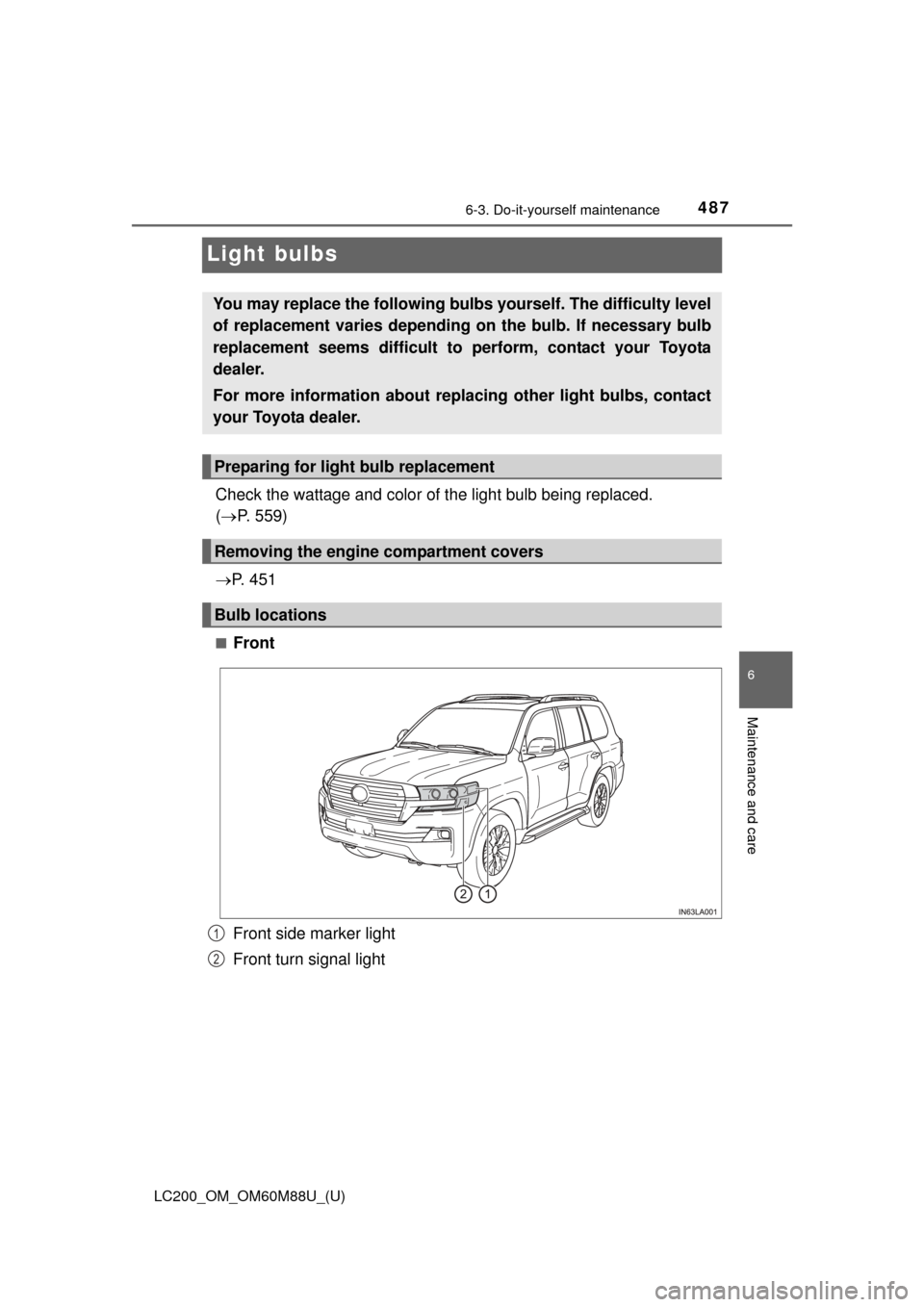
487
LC200_OM_OM60M88U_(U)
6-3. Do-it-yourself maintenance
6
Maintenance and care
Light bulbs
Check the wattage and color of the light bulb being replaced.
( P. 559)
P. 4 5 1
■Front
Front side marker light
Front turn signal light
You may replace the following bulb s yourself. The difficulty level
of replacement varies depending on the bulb. If necessary bulb
replacement seems difficult to perform, contact your Toyota
dealer.
For more information about repl acing other light bulbs, contact
your Toyota dealer.
Preparing for light bulb replacement
Removing the engine compartment covers
Bulb locations
1
2
Page 514 of 608

5147-2. Steps to take in an emergency
LC200_OM_OM60M88U_(U)
■SRS warning light
This warning light system monitors the airbag sensor assembly, front impact
sensors, side impact sensors (rear), side impact sensors (front door), safing
sensor (rear), driver’s seat belt buckle switch, driver’s seat position sensor,
front passenger’s seat belt buckle switch, airbags, interconnecting wiring and
power sources, front passenger occupant classification system, “AIR BAG
ON” and “AIR BAG OFF” indicator light s, seat belt pretensioners, “RSCA
OFF” indicator light. ( P. 38)
■ Front passenger detection sensor, seat belt reminder and warning
buzzer
● If luggage is placed on the front passenger seat, the front passenger detec-
tion sensor may cause the warning light to flash and the warning buzzer to
sound even if a passenger is not sitting in the seat.
● If a cushion is placed on the seat, the sensor may not detect a passenger,
and the warning light may not operate properly.
■ If the malfunction indicator la mp comes on while driving
First check the following:
● Is the fuel tank empty?
If it is, fill the fuel tank immediately.
● Is the fuel tank cap loose?
If it is, tighten it securely.
The light will go off after several driving trips.
If the light does not go off even after several trips, contact your Toyota dealer
as soon as possible.
■ If the low speed four-wheel drive indi cator light or the center differential
lock indicator light blinks
Take the specified steps. ( P. 282)
If the brake system warning light or the malfunction indicator light also comes
on, or the low speed four-wheel drive indicator light or the center differential
lock indicator light continues to blink after taking the specified steps, there
may be a malfunction in the engine, the brake system or the four-wheel drive
system. In this case, you may not be able to transfer between “H4” and “L4”
modes, and the center differential lock may not be able to be locked or
unlocked. Have the vehicle inspected by your Toyota dealer immediately.
Page 515 of 608

5157-2. Steps to take in an emergency
LC200_OM_OM60M88U_(U)
7
When trouble arises
■When the tire pressure warning light comes on
Inspect the tires to check if a tire is punctured.
If a tire is punctured: P. 524
If none of the tires are punctured:
Turn the engine switch off then turn it to IGNITION ON mode. Check if the
tire pressure warning light comes on or flashes.
If the tire pressure warning light comes on
After the temperature of the tires has lowered sufficiently, check the
inflation pressure of each tire and adjust them to the specified level.
If the warning light does not turn off even after several minutes have
elapsed, check that the inflation pressu re of each tire is at the specified
level and perform initialization. (P. 464)
If the warning light does not turn off even after several minutes have
elapsed, have the vehicle inspected by your Toyota dealer immediately.
If the tire pressure warning light flashes for 1 minute then stay on
There may be a malfunction in the tire pressure warning system. Have
the vehicle inspected by your Toyota dealer immediately.
■The tire pressure warning light may turn on due to natural causes
The tire pressure warning light may turn on due to natural causes such as
natural air leaks or tire inflation pressure changes caused by tempera-
ture. In this case, adjusting the tire inflation pres sure will turn off the warn-
ing light (after a few minutes).
■When a tire is replaced with a spare tire
The spare tire is also equipped with the tire pressure warning valve and
transmitter. The tire pressure warning light will turn on if the tire inflation
pressure of the spare tire is low. If a tire goes flat, even though the flat tire
is replaced with the spare tire, the tire pressure warning light does not
turn off. Replace the spare tire with the repaired tire and adjust the proper
tire inflation pressure. T he tire pressure warning light will turn off after a
few minutes.
■Conditions that the tire pressure warning system may not function
properly
P. 4 6 8
■Changing the engine oil
Make sure to reset oil change system.
1
2
Page 544 of 608
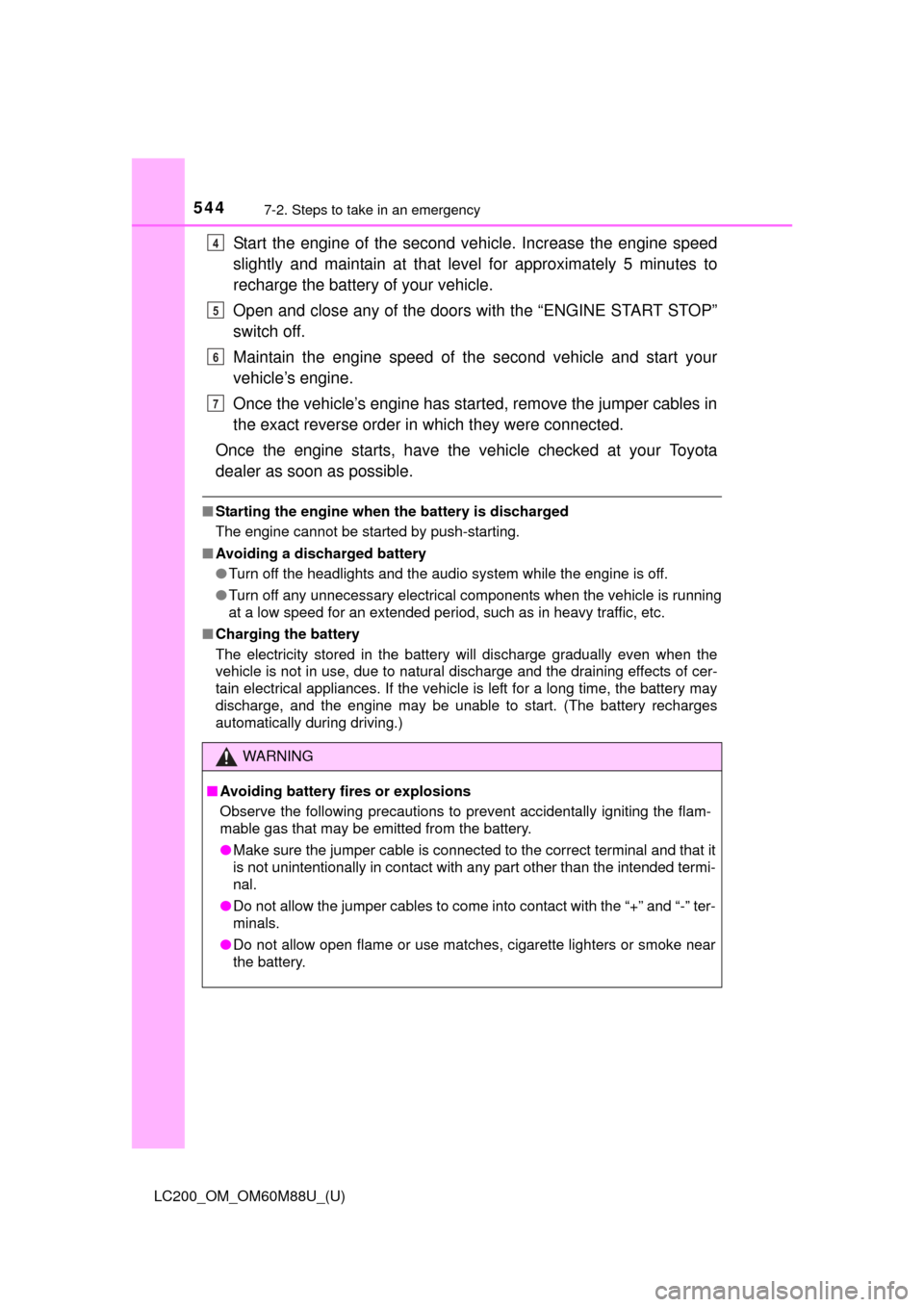
5447-2. Steps to take in an emergency
LC200_OM_OM60M88U_(U)
Start the engine of the second vehicle. Increase the engine speed
slightly and maintain at that level for approximately 5 minutes to
recharge the batter y of your vehicle.
Open and close any of the doors with the “ENGINE START STOP”
switch off.
Maintain the engine speed of the second vehicle and start your
vehicle’s engine.
Once the vehicle’s engine has started, remove the jumper cables in
the exact reverse order in which they were connected.
Once the engine starts, have the vehicle checked at your Toyota
dealer as soon as possible.
■ Starting the engine when the battery is discharged
The engine cannot be started by push-starting.
■ Avoiding a discharged battery
●Turn off the headlights and the audio system while the engine is off.
● Turn off any unnecessary electrical components when the vehicle is running
at a low speed for an extended period, such as in heavy traffic, etc.
■ Charging the battery
The electricity stored in the battery will discharge gradually even when the
vehicle is not in use, due to natural discharge and the draining effects of cer-
tain electrical appliances. If the vehicle is left for a long time, the battery may
discharge, and the engine may be unable to start. (The battery recharges
automatically during driving.)
WARNING
■Avoiding battery fires or explosions
Observe the following precautions to prevent accidentally igniting the flam-
mable gas that may be emitted from the battery.
●Make sure the jumper cable is connected to the correct terminal and that it
is not unintentionally in contact with any part other than the intended termi-
nal.
● Do not allow the jumper cables to come into contact with the “+” and “-” ter-
minals.
● Do not allow open flame or use matches, cigarette lighters or smoke near
the battery.
4
5
6
7
Page 556 of 608
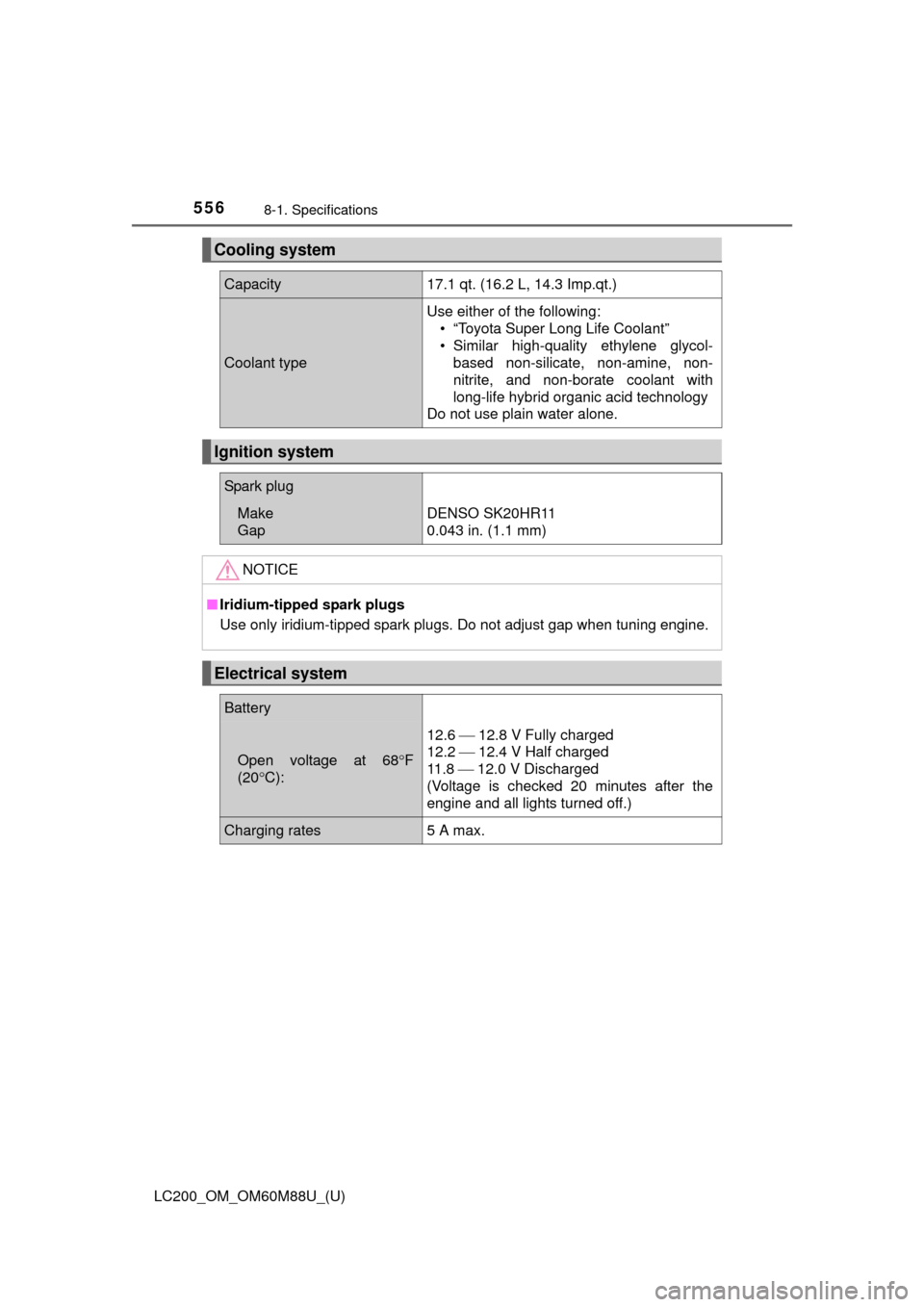
556
LC200_OM_OM60M88U_(U)
8-1. Specifications
Cooling system
Capacity17.1 qt. (16.2 L, 14.3 Imp.qt.)
Coolant type
Use either of the following:• “Toyota Super Long Life Coolant”
• Similar high-quality ethylene glycol- based non-silicate, non-amine, non-
nitrite, and non-borate coolant with
long-life hybrid organic acid technology
Do not use plain water alone.
Ignition system
Spark plug
Make
GapDENSO SK20HR11
0.043 in. (1.1 mm)
NOTICE
■ Iridium-tipped spark plugs
Use only iridium-tipped spark plugs. Do not adjust gap when tuning engine.
Electrical system
Battery
Open voltage at 68 F
(20 C):
12.6 12.8 V Fully charged
12.2 12.4 V Half charged
11 . 8 12.0 V Discharged
(Voltage is checked 20 minutes after the
engine and all lights turned off.)
Charging rates5 A max.
Page 595 of 608
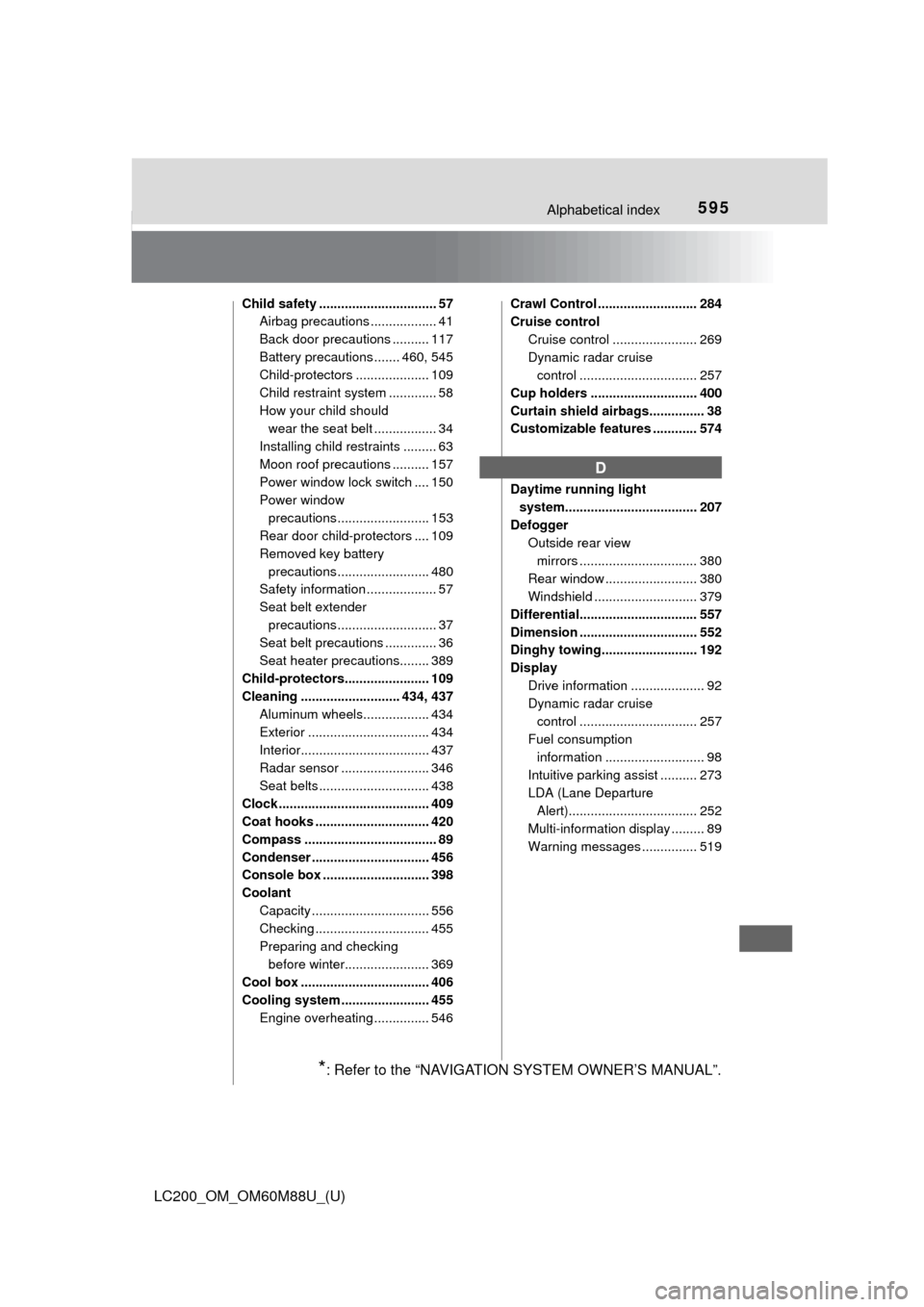
595Alphabetical index
LC200_OM_OM60M88U_(U)
Child safety ................................ 57Airbag precautions .................. 41
Back door precautions .......... 117
Battery precautions ....... 460, 545
Child-protectors .................... 109
Child restraint system ............. 58
How your child should wear the seat belt ................. 34
Installing child restraints ......... 63
Moon roof precautions .......... 157
Power window lock switch .... 150
Power window precautions ......................... 153
Rear door child-protectors .... 109
Removed key battery
precautions ......................... 480
Safety information ................... 57
Seat belt extender
precautions ........................... 37
Seat belt precautions .............. 36
Seat heater precautions........ 389
Child-protectors....................... 109
Cleaning ........................... 434, 437 Aluminum wheels.................. 434
Exterior ................................. 434
Interior................................... 437
Radar sensor ........................ 346
Seat belts .............................. 438
Clock ......................................... 409
Coat hooks ............................... 420
Compass .................................... 89
Condenser ................................ 456
Console box ............................. 398
Coolant Capacity ................................ 556
Checking ............................... 455
Preparing and checking before winter....................... 369
Cool box ................................... 406
Cooling system ........................ 455
Engine overheating ............... 546 Crawl Control ........................... 284
Cruise control
Cruise control ....................... 269
Dynamic radar cruise control ................................ 257
Cup holders ............................. 400
Curtain shield airbags............... 38
Customizable features ............ 574
Daytime running light system.................................... 207
Defogger Outside rear view
mirrors ................................ 380
Rear window ......................... 380
Windshield ............................ 379
Differential................................ 557
Dimension ................................ 552
Dinghy towing.......................... 192
Display Drive information .................... 92
Dynamic radar cruise control ................................ 257
Fuel consumption information ........................... 98
Intuitive parking assist .......... 273
LDA (Lane Departure
Alert)................................... 252
Multi-information display ......... 89
Warning messages ............... 519
D
*: Refer to the “NAVIGATION SYSTEM OWNER’S MANUAL”.